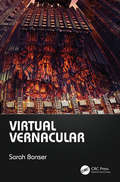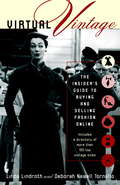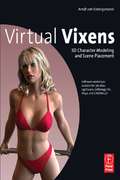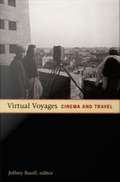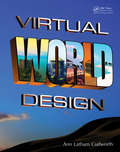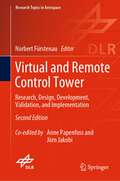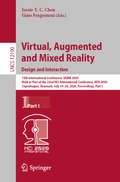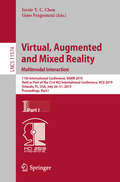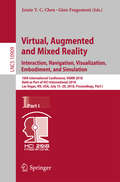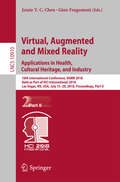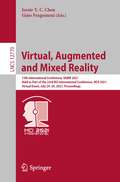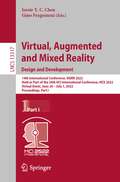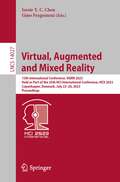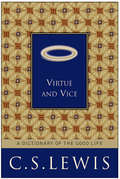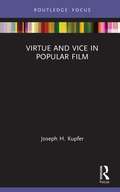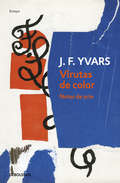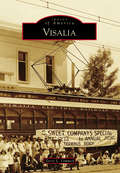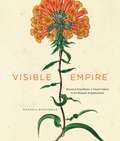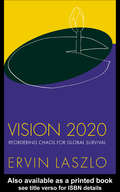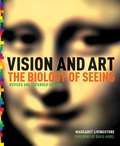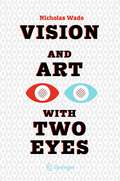- Table View
- List View
Virtual Vernacular
by Sarah BonserLearn to see the patterns and relationships in visual mediums and buildings as you push the boundaries of design. Sarah Bonser’s Virtual Vernacular breaks the barriers between architectural theory and game design. The text explores the way in which architecture can convey history, culture, and emotion to occupants, audience members, and players. Divided into three sections, the text guides the reader on how to tackle creative problem solving and development strategy. Key Features: Architectural theory is hard to navigate, and this approach is an accessible way to start learning it. Learn more specifically how pop culture parodies these design theories. Find ways to solve abstract design problems by using the built environment as a case study. Learn about technical limitations on the built environment that visually impact the look and feel of spaces. Each piece of architectural theory comes with abstracts and applications, which is a more organized and network-style way to teach an otherwise long-winded subject.
Virtual Vintage: The Insider's Guide to Buying and Selling Fashion Online
by Linda Lindroth Deborah Newell TornelloVintage clothing has never been more chic, with everyone from celebrity trendsetters to style-conscious professionals searching for wearable treasures from the past. Virtual Vintage is the first and only guide that helps both the novice and the fashion connoisseur evaluate and confidently participate in the thriving vintage marketplace that exists online. No other book explains how to get it, sell it, fix it, or wear it with flair. Authors Linda Lindroth and Deborah Newell Tornello equip readers from head to toe with * more than 100 chic sites--rated and evaluated * instructions on contacting sellers * smart strategies for bidding in online auctions * advice about evaluating the size, quality, and colors of a garment * tips for cleaning and repairing vintage items Whether you're looking for a 1960s Rudi Gernreich knit, Gucci hipster trousers, a Claire McCardell for Townley shirtwaist, or a Chanel suit in pink wool with black patent-leather trim, Virtual Vintage will help you build a unique and sensational wardrobe.
Virtual Vixens: 3D Character Modeling and Scene Placement
by Arndt Von KoenigsmarckFeatures software workshops for 3ds Max, Maya, CINEMA 4D, Lightwave, and Softimage XSI.Hot, hotter, hottest. See how today's leading modeling artists create 3D characters that sizzle and get the techniques you'll need to create your own virtual vixens.Steven Stahlberg, Liam Kemp, Marco Patrito, and Sze Jones from Blur Studio are just a few of the 3D artists who share their secrets for making the fantasy females you wish were real. You'll get their personal stories, insights into the profession, and new ways to conceive and construct your own 3D characters.Then, seven hands-on workshops demonstrate the complete work cycle of modeling 3D characters to bring your own fantasies to life-from making the first sketch and preparing the template to modeling and texturing characters and lighting and rendering. You can use the techniques with any of the major software tools including 3ds Max, Lightwave, Softimage XSI, Maya, or Cinema 4D. Since the workshops don't use any previously made objects, you'll get to start from scratch with your imagination as the only limit.Participants:Andrea BertacciniMax Edwin WahyudiSze JonesLiam KempArndt von KoenigsmarckK. C. LeeDaniel Moreno DiazMarco PatritoSteven StahlbergFrancois de Swardt
Virtual Voyages: Cinema and Travel
by Jeffrey RuoffVirtual Voyages illuminates the pivotal role of travelogues within the history of cinema. The travelogue dominated the early cinema period from 1895 to 1905, was central to the consolidation of documentary in the 1910s and 1920s, proliferated in the postwar era of 16mm distribution, and today continues to flourish in IMAX theaters and a host of non-theatrical venues. It is not only the first chapter in the history of documentary but also a key element of ethnographic film, home movies, and fiction films. In this collection, leading film scholars trace the intersection of technology and ideology in representations of travel across a wide variety of cinematic forms. In so doing, they demonstrate how attention to the role of travel imagery in film blurs distinctions between genres and heightens awareness of cinema as a technology for moving through space and time, of cinema itself as a mode of travel. Some contributors take a broad view of travelogues by examining the colonial and imperial perspectives embodied in early travel films, the sensation of movement that those films evoked, and the role of live presentations such as lectures in our understanding of travelogues. Other essays are focused on specific films, figures, and technologies, including early travelogues encouraging Americans to move to the West; the making and reception of the documentary Grass (1925), shot on location in Turkey, Syria, Iraq, and Iran; the role of travel imagery in 1930s Hollywood cinema; the late-twentieth-century 16mm illustrated-lecture industry; and the panoramic possibilities presented by IMAX technologies. Together the essays provide a nuanced appreciation of how, through their representations of travel, filmmakers actively produce the worlds they depict. Contributors. Rick Altman, Paula Amad, Dana Benelli, Peter J. Bloom, Alison Griffiths, Tom Gunning, Hamid Naficy, Jennifer Lynn Peterson, Lauren Rabinovitz, Jeffrey Ruoff, Alexandra Schneider, Amy J. Staples
Virtual World Design
by Ann CudworthLearn How to Create Immersive Virtual EnvironmentsWritten by an award-winning designer with 20 years of experience designing virtual environments for television and online communities, Virtual World Design explores the intertwining disciplines of 2D graphics, 3D models, lighting, sound, and storytelling. It illustrates how these disciplines come to
Virtual and Remote Control Tower: Research, Design, Development, Validation, and Implementation (Research Topics in Aerospace)
by Norbert FürstenauThis book presents the interdisciplinary and international “Virtual and Remote Tower” research and development work. It has been carried out since nearly twenty years with the goal of replacing the conventional aerodrome control tower by a new “Remote Tower Operation” (RTO) work environment for enhancing work efficiency and safety and reducing cost. The revolutionary human–system interface replaces the out-of-windows view by an augmented vision video panorama that allows for remote aerodrome traffic control without a physical tower building. It enables the establishment of a (multiple) remote control center (MRTO, RTC) that may serve several airports from a central location. The first (2016) edition of this book covered all aspects from preconditions over basic research and prototype development to initial validation experiments with field testing. Co-edited and -authored by DLR RTO-team members Dr. Anne Papenfuss and Jörn Jakobi, this second extended edition with nearly doubled number of chapters includes further important aspects of the international follow-up work towards the RTO-deployment. Focus of the extension with new contributions from ENRI/Japan and IAA/Dublin with Cranfield University, is on MRTO, workload, implementation, and standardization. Specifically, the two revised and nine new Chapters put the focus on inclusion of augmented vision and virtual reality technologies, human-in-the-loop simulation for quantifying workload and deriving minimum (technical) requirements according to standards of the European Organization for Civil Aviation Equipment (EUROCAE), and MRTO implementation and certification. Basics of optical / video design, workload measures, and advanced psychophysical data analysis are presented in four appendices.
Virtual und Augmented Reality: Grundlagen und Methoden der Virtuellen und Augmentierten Realität (eXamen.press)
by Ralf Dörner, Wolfgang Broll, Paul Grimm and Bernhard JungDas Lehrbuch vermittelt die theoretischen und praktischen Grundlagen, die benötigt werden, um Virtual- und Augmented-Reality-Systeme (VR/AR) eigenständig zu realisieren oder zu erweitern. Es dient Studierenden als anschauliche Begleitlektüre zu Lehrveranstaltungen, die VR/AR thematisieren, u. a. in den Fächern Informatik, Medien oder Natur- und Ingenieurwissenschaften. Durch seinen modularen Aufbau eignet sich der Band auch für das Selbststudium und kann darüber hinaus als Nachschlagewerk verwendet werden.
Virtual, Augmented and Mixed Reality. Design and Interaction: 12th International Conference, VAMR 2020, Held as Part of the 22nd HCI International Conference, HCII 2020, Copenhagen, Denmark, July 19–24, 2020, Proceedings, Part I (Lecture Notes in Computer Science #12190)
by Gino Fragomeni Jessie Y. C. ChenThe 2 volume-set of LNCS 12190 and 12191 constitutes the refereed proceedings of the 12th International Conference on Virtual, Augmented and Mixed Reality, VAMR 2020, which was due to be held in July 2020 as part of HCI International 2020 in Copenhagen, Denmark. The conference was held virtually due to the COVID-19 pandemic.A total of 1439 papers and 238 posters have been accepted for publication in the HCII 2020 proceedings from a total of 6326 submissions.The 71 papers included in these HCI 2020 proceedings were organized in topical sections as follows:Part I: design and user experience in VAMR; gestures and haptic interaction in VAMR; cognitive, psychological and health aspects in VAMR; robots in VAMR.Part II: VAMR for training, guidance and assistance in industry and business; learning, narrative, storytelling and cultural applications of VAMR; VAMR for health, well-being and medicine.
Virtual, Augmented and Mixed Reality. Multimodal Interaction: 11th International Conference, VAMR 2019, Held as Part of the 21st HCI International Conference, HCII 2019, Orlando, FL, USA, July 26–31, 2019, Proceedings, Part I (Lecture Notes in Computer Science #11574)
by Gino Fragomeni Jessie Y. C. ChenThis two-volume set LNCS 11574 and 11575 constitutes the refereed proceedings of the 11th International Conference on Virtual, Augmented and Mixed Reality, VAMR 2019, held in July 2019 as part of HCI International 2019 in Orlando, FL, USA. HCII 2019 received a total of 5029 submissions, of which 1275 papers and 209 posters were accepted for publication after a careful reviewing process. The 80 papers presented in this volume were organized in topical sections named: multimodal interaction in VR, rendering, layout, visualization and navigation, avatars, embodiment and empathy in VAMR, cognitive and health issues in VAMR, VAMR and robots, VAMR in learning, training and entertainment, VAMR in aviation, industry and the military.
Virtual, Augmented and Mixed Reality: 10th International Conference, VAMR 2018, Held as Part of HCI International 2018, Las Vegas, NV, USA, July 15-20, 2018, Proceedings, Part I (Lecture Notes in Computer Science #10909)
by Jessie Y.C. Chen Gino FragomeniThis two-volume set LNCS 10909 and 10910 constitutes the refereed proceedings of the 10th International Conference on Virtual, Augmented and Mixed Reality, VAMR 2018, held as part of HCI International 2018 in Las Vegas, NV, USA. HCII 2018 received a total of 4346 submissions, of which 1171 papers and 160 posters were accepted for publication after a careful reviewing process. The 65 papers presented in this volume were organized in topical sections named: interaction, navigation, and visualization in VAMR; embodiment, communication, and collaboration in VAMR; education, training, and simulation; VAMR in psychotherapy, exercising, and health; virtual reality for cultural heritage, entertainment, and games; industrial and military applications.
Virtual, Augmented and Mixed Reality: 10th International Conference, VAMR 2018, Held as Part of HCI International 2018, Las Vegas, NV, USA, July 15-20, 2018, Proceedings, Part II (Lecture Notes in Computer Science #10910)
by Jessie Y.C. Chen Gino FragomeniThis two-volume set LNCS 10909 and 10910 constitutes the refereed proceedings of the 10th International Conference on Virtual, Augmented and Mixed Reality, VAMR 2018, held as part of HCI International 2018 in Las Vegas, NV, USA. HCII 2018 received a total of 4346 submissions, of which 1171 papers and 160 posters were accepted for publication after a careful reviewing process. The 65 papers presented in this volume were organized in topical sections named: interaction, navigation, and visualization in VAMR; embodiment, communication, and collaboration in VAMR; education, training, and simulation; VAMR in psychotherapy, exercising, and health; virtual reality for cultural heritage, entertainment, and games; industrial and military applications.
Virtual, Augmented and Mixed Reality: 13th International Conference, VAMR 2021, Held as Part of the 23rd HCI International Conference, HCII 2021, Virtual Event, July 24–29, 2021, Proceedings (Lecture Notes in Computer Science #12770)
by Gino Fragomeni Jessie Y. C. ChenThis book constitutes the refereed proceedings of the 13th International Conference on Virtual, Augmented and Mixed Reality, VAMR 2021, held virtually as part of the 23rd HCI International Conference, HCII 2021, in July 2021. The total of 1276 papers and 241 posters included in the 39 HCII 2021 proceedings volumes was carefully reviewed and selected from 5222 submissions. The 47 papers included in this volume were organized in topical sections as follows: designing and evaluating VAMR environments; multimodal and natural interaction in VAMR; head-mounted displays and VR glasses; VAMR applications in design, the industry and the military; and VAMR in learning and culture.
Virtual, Augmented and Mixed Reality: 14th International Conference, VAMR 2022, Held as Part of the 24th HCI International Conference, HCII 2022, Virtual Event, June 26 – July 1, 2022, Proceedings, Part I (Lecture Notes in Computer Science #13317)
by Gino Fragomeni Jessie Y. C. ChenThis two-volume set LNCS 13317 and 13318 constitutes the thoroughly refereed proceedings of the 14th International Conference on Virtual, Augmented and Mixed Reality, VAMR 2022, held virtually as part of the 24rd HCI International Conference, HCII 2022, in June/July 2022.The total of 1276 papers and 241 posters included in the 39 HCII 2021 proceedings volumes was carefully reviewed and selected from 5222 submissions. The 56 papers included in this 2-volume set were organized in topical sections as follows: Developing VAMR Environments; Evaluating VAMR environments; Gesture-based, haptic and multimodal interaction in VAMR; Social, emotional, psychological and persuasive aspects in VAMR; VAMR in learning, education and culture; VAMR in aviation; Industrial applications of VAMR. The first volume focuses on topics related to developing and evaluating VAMR environments, gesture-based, haptic and multimodal interaction in VAMR, as well as social, emotional, psychological and persuasive aspects in VAMR, while the second focusses on topics related to VAMR in learning, education and culture, VAMR in aviation, and industrial applications of VAMR.
Virtual, Augmented and Mixed Reality: 15th International Conference, VAMR 2023, Held as Part of the 25th HCI International Conference, HCII 2023, Copenhagen, Denmark, July 23–28, 2023, Proceedings (Lecture Notes in Computer Science #14027)
by Gino Fragomeni Jessie Y. C. ChenThis book constitutes the refereed proceedings of the 15th International Conference on Virtual, Augmented and Mixed Reality, VAMR 2023, held as part of the 25th International Conference, HCI International 2023, in Copenhagen, Denmark, in July 2023. The total of 1578 papers and 396 posters included in the HCII 2022 proceedings was carefully reviewed and selected from 7472 submissions. The VAMR 2023 proceedings were organized in the following topical sections: Designing VAMR Applications and Environments; Visualization, Image Rendering and 3D in VAMR; Multimodal Interaction in VAMR; Robots and Avatars in Virtual and Augmented Reality; VAMR in Medicine and Health; VAMR in Aviation; and User Experience in VAMR.
Virtue and Vice
by C. S. LewisA Pocket Guide to Goodness Few writers have inspired more readers than author C. S. Lewis -- both through the enchanting volumes of his children's series and through his captivating adult classics such as Mere Christianity, The Screwtape Letters, The Great Divorce, and numerous others. Drawn from many works, this volume collects dictionary-like entries of Lewis's keenest observations and best advice on how to live a truly good life. From ambition to charity, despair to duty, hope to humility, Lewis delivers clear, illuminating definitions to live by.
Virtue and Vice in Popular Film (Routledge Focus on Film Studies)
by Joseph H. KupferThis book addresses a prominent group of virtues and vices as portrayed in popular films to further our understanding of these moral character traits. The discussions emphasize the interplay between the philosophical conception of the virtues and vices and the cinematic representations of character. Joseph H. Kupfer explores how fictional characters possessing certain moral strengths and weaknesses concretize our abstract understanding of them. Because the actions that flow from these traits occur in cinematic contexts mirroring real world conditions, the narrative portrayals of these moral characteristics can further our appreciation of their import. Humility, integrity, and perseverance, for example, are depicted in Chariots of Fire, The Fabulous Baker Boys, and Billy Elliot, while the vices of envy, arrogance and vanity are captured in Amadeus, Whiplash, and Young Adult. This interdisciplinary work in philosophy and film criticism will be of great interest to scholars and students of film studies, philosophy of film, ethics, aesthetics, and popular culture.
Virutas de color: Notas de arte
by José Francisco YvarsUna selección de artículos y escritos monográficos de J.F. Yvars en los que reflexiona acerca de distintos aspectos del arte del siglo XX, ofreciéndonos una mirada transversal de este mundo: del artista al coleccionista, de la obra a la reflexión crítica. Moviéndose entre tiempos y lugares, viajando a los rincones más recónditos del arte, los ensayos reunidos en Virutas de color trazan un itinerario lleno de contrastes. En los artículos monográficos que conforman la primera parte de este volumen, Yvars reflexiona en torno al cambio de paradigma artístico en los albores del arte abstracto a través de la obra de André Masson y el artista Ràfols-Casamada. Se adentra asimismo en cuestiones que atañen a la teoría estética a través de dos referentes ineludibles de la contemporaneidad: Ernst Gombrich y Cesare Brandi. A su vez, la segunda parte del libro recoge una selección de artículos -algunos de ellos publicados anteriormente enLa Vanguardia y ampliados para esta edición; otros, inéditos- mediante la cual Yvars dialoga con figuras fundamentales de la historia, la crítica del arte y el coleccionismo. Reseñas:«J. F. Yvars ha hecho del arte su camino en la vida.»El País «Yvars lleva más de medio siglo descifrando la experiencia estética en palabras.»Sergi Doria, ABC
Visalia (Images of America)
by Terry L. OmmenWhen the first settlers arrived in what is now Visalia in the fall of 1852, they found a lush river delta in the midst of an oak forest at the base of the Sierra Nevada. The soil was fertile, just right for farming, enabling Visalia to take root as the oldest town in the southern San Joaquin Valley. For the next 163 years, the town provided important products and services, like David Walker's Saddle Shop that became home to the famous Visalia Stock Saddle and Ben Maddox's Mount Whitney Power Company that harnessed water from the Kaweah River for electricity. Now with a population of almost 130,000, the county seat of Tulare County continues to be surrounded by some of the most productive farmland in the world and is a vibrant business center.
Visible Empire: Botanical Expeditions and Visual Culture in the Hispanic Enlightenment
by Daniela BleichmarBetween 1777 and 1816, botanical expeditions crisscrossed the vast Spanish empire in an ambitious project to survey the flora of much of the Americas, the Caribbean, and the Philippines. While these voyages produced written texts and compiled collections of specimens, they dedicated an overwhelming proportion of their resources and energy to the creation of visual materials. European and American naturalists and artists collaborated to manufacture a staggering total of more than 12,000 botanical illustrations. Yet these images have remained largely overlooked—until now. In this lavishly illustrated volume, Daniela Bleichmar gives this archive its due, finding in these botanical images a window into the worlds of Enlightenment science, visual culture, and empire. Through innovative interdisciplinary scholarship that bridges the histories of science, visual culture, and the Hispanic world, Bleichmar uses these images to trace two related histories: the little-known history of scientific expeditions in the Hispanic Enlightenment and the history of visual evidence in both science and administration in the early modern Spanish empire. As Bleichmar shows, in the Spanish empire visual epistemology operated not only in scientific contexts but also as part of an imperial apparatus that had a long-established tradition of deploying visual evidence for administrative purposes.
Visible and Invisible Whiteness: American White Supremacy through the Cinematic Lens
by Alice Mikal CravenVisible and Invisible Whiteness examines the complicity between Classical Hollywood narratives or genres and representations of white supremacy in the cinema. Close readings of D.W. Griffith’s The Birth of a Nation by James Agee and James Baldwin explore these authors’ perspectives on the American mythologies which ground Griffith’s film. The intersectionality of Bordwell’s theories on Classical Hollywood Narrative versus Art Cinema and Richard Dyer’s seminal work on whiteness forms the theoretical base for the book. Featured films are those which have been undervalued or banned due to their hybrid natures with respect to Hollywood and Art Cinema techniques, such as Samuel Fuller’s White Dog and Jean Renoir’s The Southerner. The book offers comparative analyses of American studio-based directors as well as European and European émigrés directors. It appeals to scholars of Film Theory, African American and Whiteness Studies. It provides insight for readers concerned about the re-emergence of white supremacist tensions in contemporary America.
Visio Services Quick Guide
by Sahil Malik Srini SistlaIn this fast-paced 100-page guide, you'll learn to load, display and interact with dynamic, data-powered Visio diagrams in SharePoint 2013 or Office 365. Visio Services Quick Guide gives you the tools to build anything from a simple project workflow to an organizational infrastructure diagram, powered by real data from SharePoint or SQL Server. Colleagues can load your diagrams entirely in the browser, meaning that a single Visio client installation is enough to get started. Readers with JavaScript experience will also find out how to get additional control over Visio diagrams using the JavaScript mashup API, and how to build a custom data provider. The final chapter covers some useful information on administering Visio Services. Get started bringing your Visio diagrams to life with the Visio Services Quick Guide.
Vision 2020: Reordering Chaos For Global Survival
by Ervin LaszloThis revised edition of the classic text of the period provides both the student and the specialist with an informative account of post-Roman English society.
Vision Based Identification and Force Control of Industrial Robots (Studies in Systems, Decision and Control #404)
by Subir Kumar Saha Santanu Chaudhury Abdullah Aamir Hayat Shraddha Chaudhary Riby Abraham Boby Arun Dayal Udai Sumantra Dutta RoyThis book focuses on end-to-end robotic applications using vision and control algorithms, exposing its readers to design innovative solutions towards sensors-guided robotic bin-picking and assembly in an unstructured environment. The use of sensor fusion is demonstrated through a bin-picking task of texture-less cylindrical objects. The system identification techniques are also discussed for obtaining precise kinematic and dynamic parameters of an industrial robot which facilitates the control schemes to perform pick-and-place tasks autonomously without any interference from the user. The uniqueness of this book lies in a judicious balance between theory and technology within the context of industrial application. Therefore, it will be valuable to researchers working in the area of vision- and force control- based robotics, as well as beginners in this inter-disciplinary area, as it deals with the basics and technologically advanced research strategies.
Vision and Art
by Margaret S. Livingstone David Hubel<p>With the original release of Vision and Art in 2002, Harvard professor Margaret Livingstone successfully bridged the gap between science and art, exploring how great painters fool the brain: why Mona Lisa’s smile seems so mysterious, or Monet’s Poppy Field appears to sway. In the revised and expanded edition, Livingstone presents two new chapters of her latest observations, has substantially expanded other chapters, and updates the rest of the existing text with new insights gleaned from her ongoing research, bringing the book to the cutting edge in the field of neuroscience. <p>Accompanying Livingstone’s lively prose are many charts and diagrams that lucidly illustrate her points, as well as in-depth analyses of the phenomena found in major works of art. Be it the explanation of common optical illusions or the breakdown of techniques painters use to create those illusions, Vision and Art provides a wealth of information for artists, scholars, and scientists alike.</p>
Vision and Art with Two Eyes (Vision, Illusion and Perception #3)
by Nicholas WadeThis book celebrates binocular vision by presenting illustrations that require two eyes to see the effects of cooperation and competition between them. Pictures are flat but by printing them in different colours and viewing them through similarly coloured filters (included with the book) they are brought to life either in stereoscopic depth or in rivalry with one another. They are called anaglyphs and all those in the book display the ways in which the eyes interact. Thus, the reader is an integral element in the book and not all readers will see the same things. The history, science and art of binocular vision can be experienced in ways that are not usually available to us and with images made specifically for this book. The study of vision with two eyes was transformed by the invention of stereoscopes in the early 19th century. Anaglyphs are simple forms of stereoscopes that have three possible outcomes from viewing them – with each eye alone to see the monocular images, with both eyes to see them in stereoscopic depth or rivalry, or without the red/cyan glasses where they can have an appeal independent of the binocularity they encompass. Through the binocular pictures and the words that accompany them there will be an appreciation of just how remarkable the processes are that yield binocular singleness and depth. Moreover, the opportunities for expressing these processes are explored with many examples of truly binocular art.
